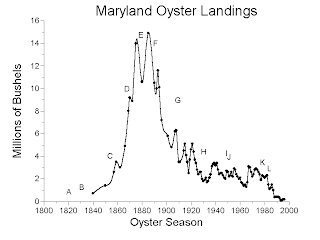“We’ve probably got more oysters here than we’ve had in the last 20 years,” said Greg Price, a waterman based in this small fishing village near Deal Island in Somerset County. “It’s a bumper crop for what we’ve been having.”Still, the best in 20 years, and double last years pitiful harvest aren't really very good by historical standards; maybe 2% of the number that were harvested in the golden ages after the Civil War and maybe 10% of the amount that was harvested back in the roaring 1970's.
...
“It’s actually created a situation now where we’re running out of oyster tags,” said Mike Naylor, head of DNR’s shellfish program. “We’ve just never been in this situation where we’re in December and we still have demand for tags.”
Despite the ensuing rationing, the agency has distributed 200,000 tags since the season began Oct. 1 compared with 135,000 all of last season, Naylor said. The season doesn’t end until March 31.
The agency is still tabulating the results of the first month of the season, but the industry appears to be on track to double or triple last year’s harvest of 135,000 bushels, Naylor added.
And how do the authorities account for the bountiful year?
Scientists aren’t sure what’s driving the comeback, Naylor said. The past couple years of relatively dry weather ensure higher saltwater content in the Chesapeake Bay and better growing conditions for oysters. But those conditions also typically fuel parasitic growth as well.So, even though they're doing better, it's still not very good, and we don't know why it happened. My plan. Stop fishing for wild oysters for 5 years and see if they show recovery. If not, plant non-natives. If they do, allow them to get to a decent density before restarting any fishing.
Don’t chalk up the bonanza to cleaner water, Naylor cautioned. If that were the case, the gigantic harvests of the 1960s and 1970s, when the Chesapeake was the mid-Atlantic’s sewer, wouldn’t have existed.What is known: Higher survival leads to more oysters reaching adulthood, which means greater reproduction and bigger harvests.
And the watermen are still whining...
And for Price, who has been chasing the elusive oyster for 45 years, it paradoxically means a hard way to make a living just got harder.“I think we’re victims of the abundance of oysters this year,” said Price, 65. “Last year, oysters held on to $30 (a bushel) the whole year, but that’s not going to happen this year.”

No comments:
Post a Comment